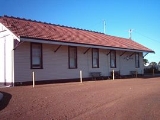
Lake Grace, Western Australia
Encyclopedia
Natural disasters
In late 2005 and early 2006, Lake Grace experienced two natural disasters. The first was a hailHail
Hail is a form of solid precipitation. It consists of balls or irregular lumps of ice, each of which is referred to as a hail stone. Hail stones on Earth consist mostly of water ice and measure between and in diameter, with the larger stones coming from severe thunderstorms...
storm on 16 October 2005, which destroyed 500 hectare
Hectare
The hectare is a metric unit of area defined as 10,000 square metres , and primarily used in the measurement of land. In 1795, when the metric system was introduced, the are was defined as being 100 square metres and the hectare was thus 100 ares or 1/100 km2...
s of wheat and barley crop and damaged a further 5,500 hectares, with some farmers reporting fields covered by up to 25 cm of hail and kilometres of road turned white. It was accompanied by about 60 mm of rainfall.
On 13 January 2006, the town was flooded by Tropical Cyclone Clare
2005-06 Australian region cyclone season
The 2005–06 Australian region cyclone season was an event in the ongoing cycle of tropical cyclone formation. It began on 1 November 2005 and ended on 30 April 2006...
, receiving 230 mm of rainfall. It was declared a disaster zone by the State Government. Just over a week later, the town was hit again by rain from Tropical Cyclone Daryl. Large pumps were brought in to help dry out flooded roads, and the main highway to Perth was reopened six weeks later.
According to the Bureau of Meteorology
Bureau of Meteorology
The Bureau of Meteorology is an Executive Agency of the Australian Government responsible for providing weather services to Australia and surrounding areas. It was established in 1906 under the Meteorology Act, and brought together the state meteorological services that existed before then...
, Lake Grace normally receives 353.3 mm of rainfall per annum with 16.3 mm in January.

